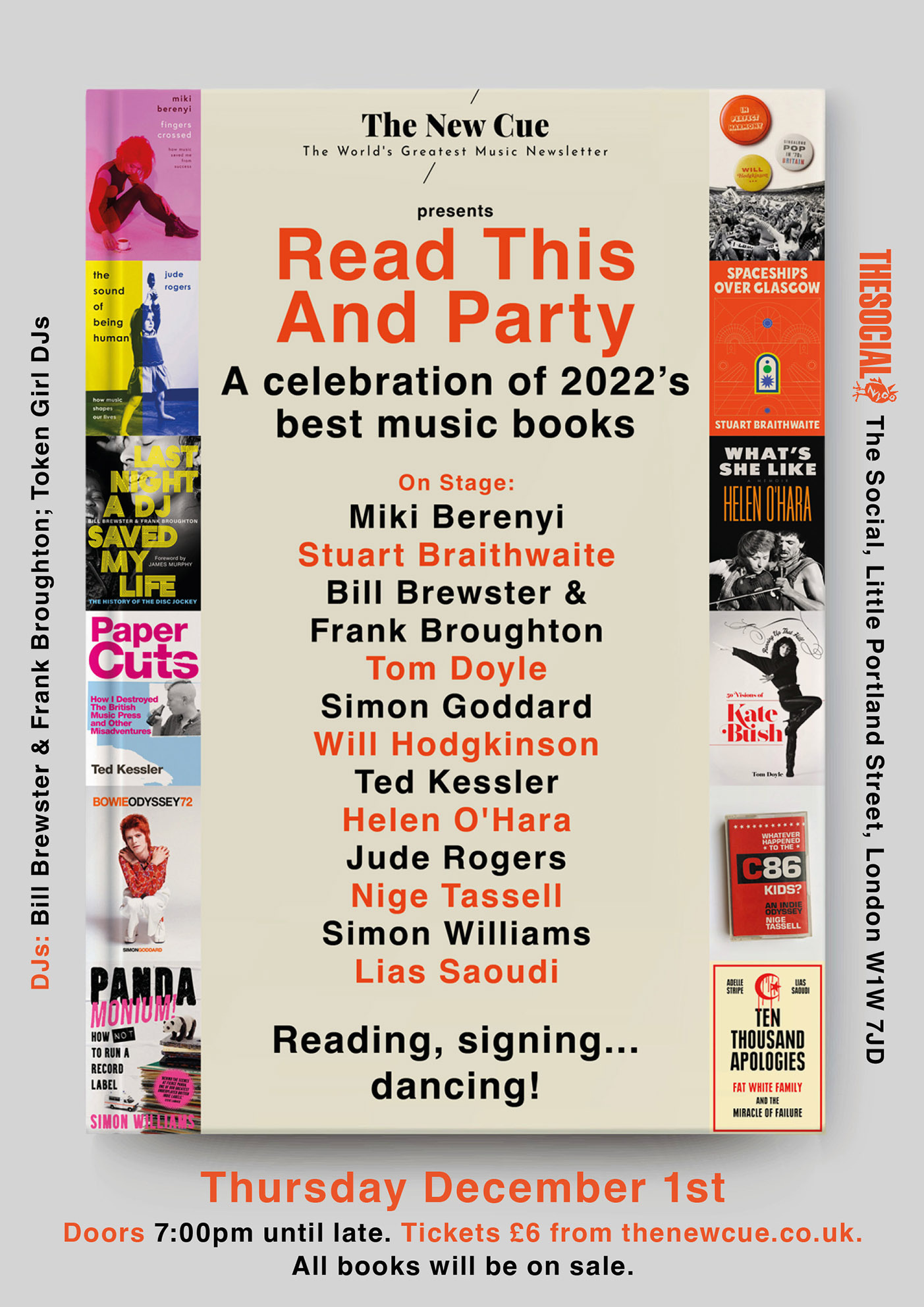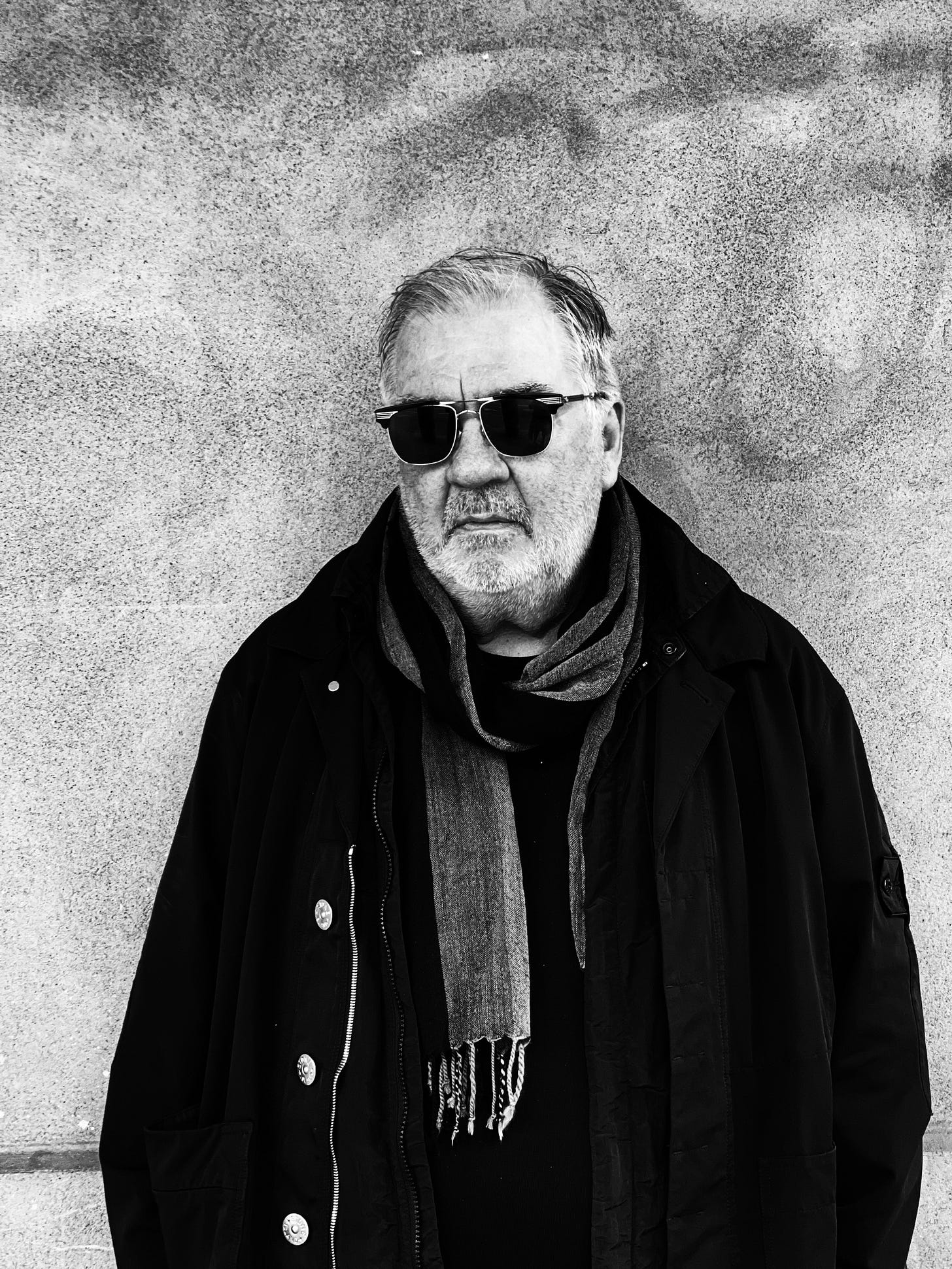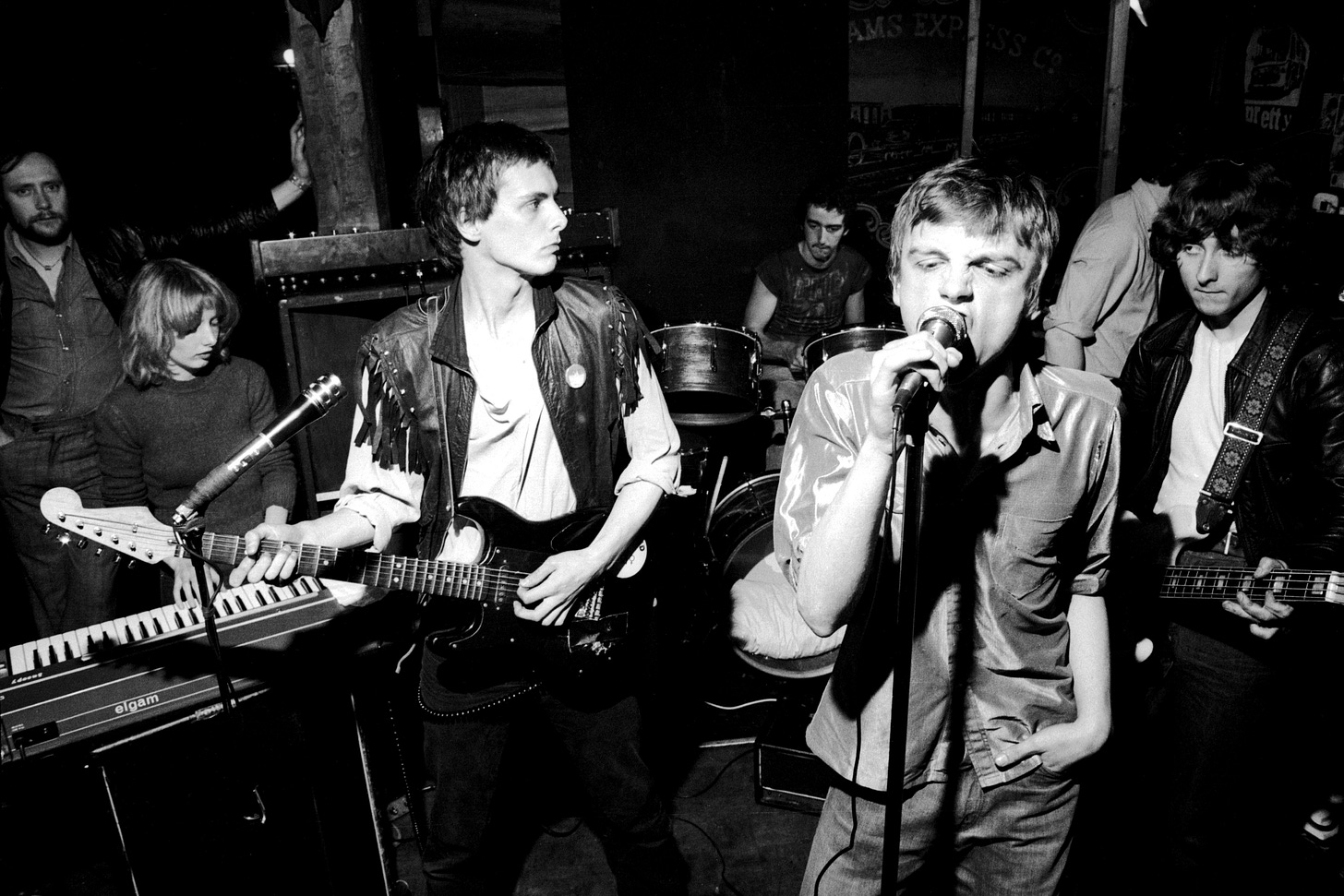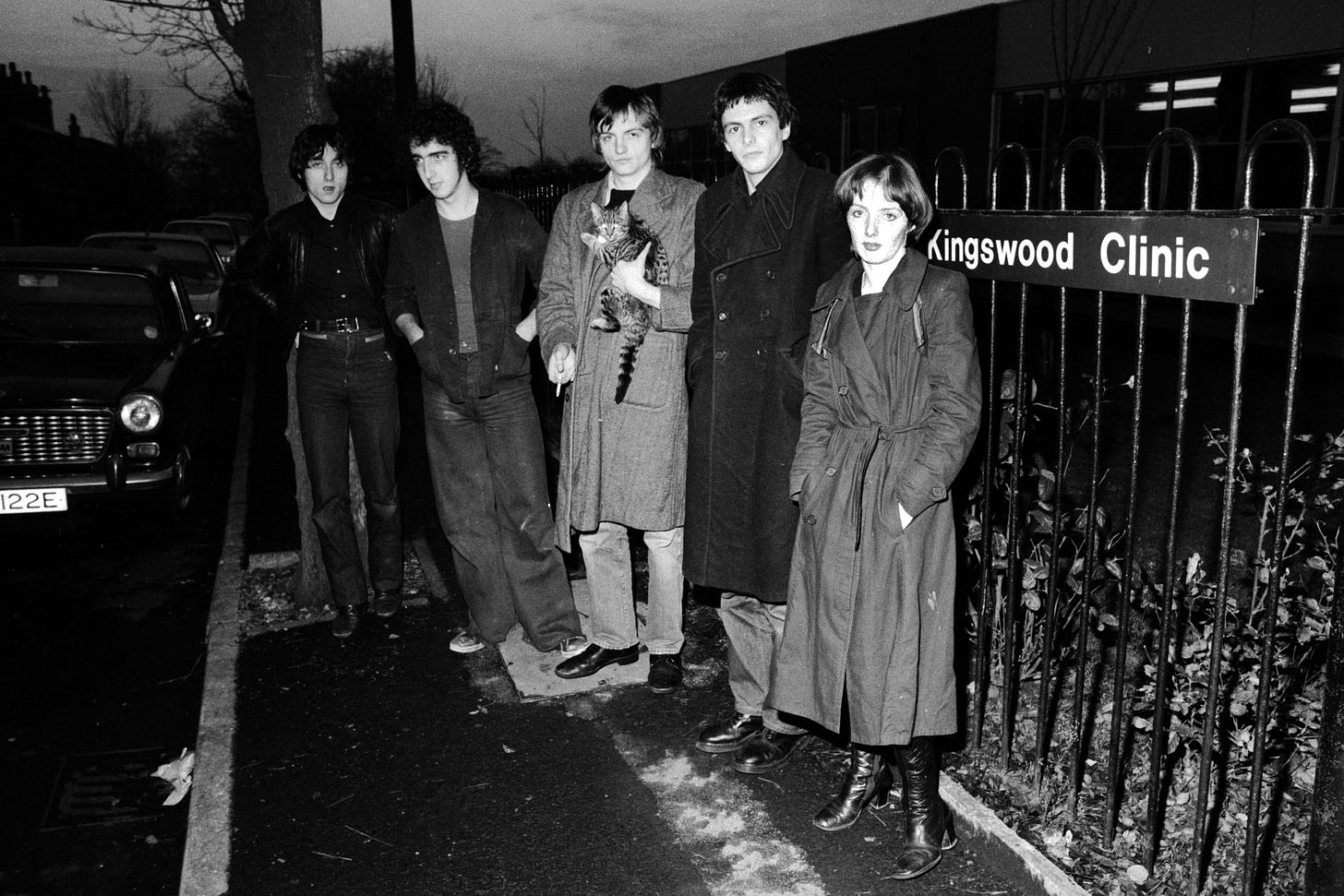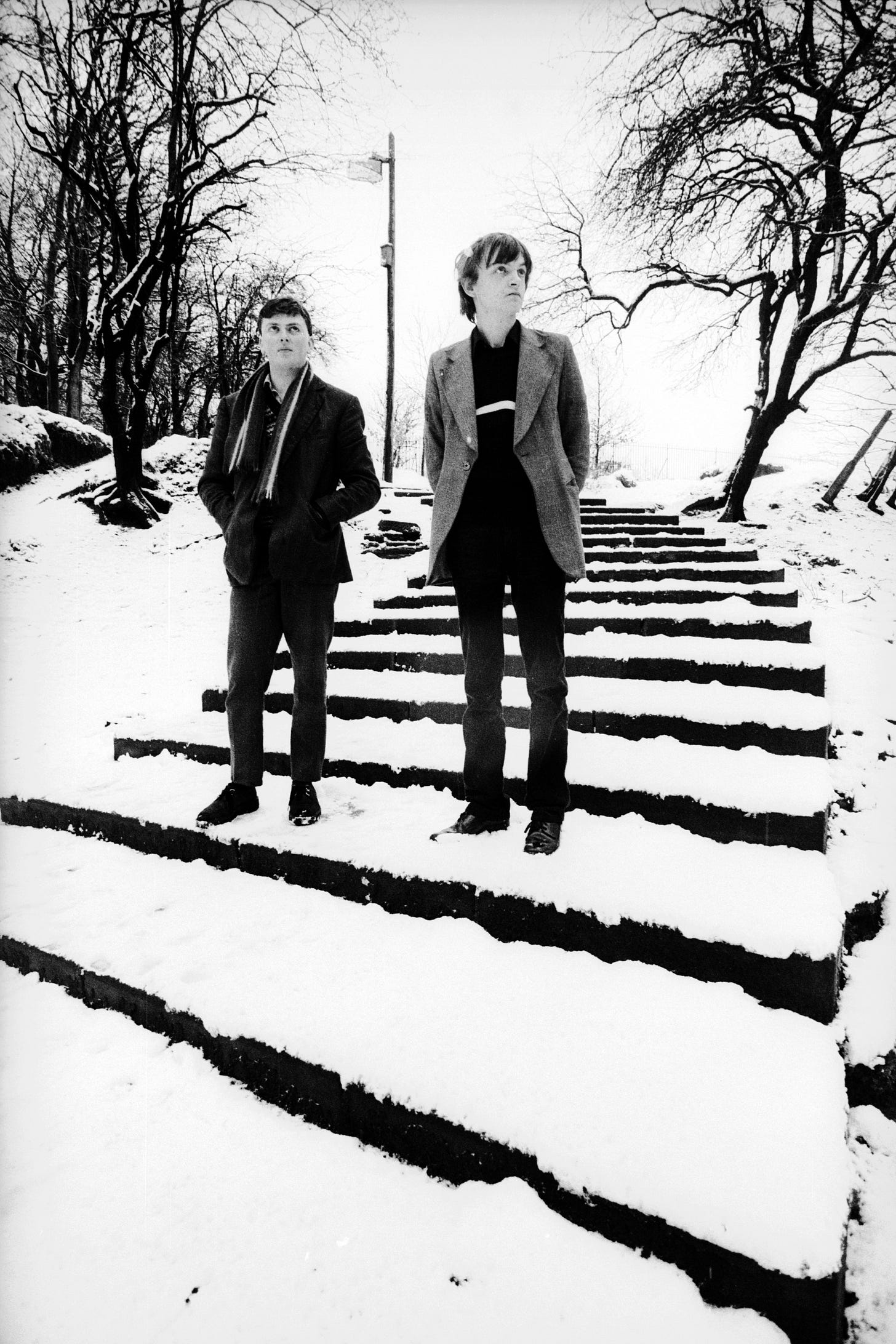Happy Halloween!
Do we start a music newsletter like that? Feels weird, but that’s the date. Trick or treat? Treat, obviously: we have the first of a two-part interview with lens legend Kevin Cummins today as our gift to you. Kevin’s got a new book about The Fall out and he’ll be guiding us through a selection of his photos from it today and on Wednesday. It’s too good, and too long, to fit in one edition. Here, have a chronological Fall playlist to listen to as you read.
Just a little reminder that in one month, on December 1st, we are having a New Cue Christmas party at The Social in London. We have an all-star line-up, a late license and about a dozen tickets left so I can guarantee a very good night. Buy your tickets for six quid here.
But that’s next month. Today, join us in the bar of Norman’s Coach & Horses in Soho. First round is on Kevin Cummins.
Enjoy the edition and see you Wednesday,
Ted, Niall and Chris.
Start The Week With… Kevin Cummins
Kevin Cummins, photo by Ella Cummins.
Kevin Cummins’ photography defined not just NME during the late ‘70s, ‘80s and 1990s - it also helped define some of Britain’s most important and lasting music of the time too. Joy Division in the snow and rehearsing in Manchester; The Stone Roses covered in paint; The Smiths, lying on grass in a Manchester suburb or Morrissey rolling around on stage; Shaun Ryder hanging from the massive E of a HOTEL sign in Spain, having his head shaved in Cuba or wading through debris on stage with Bez in Brazil; Bernard Sumner of New Order walking down an American street, hair immaculate; Madonna, dancing at the Hacienda; Polly Harvey, hair in rollers, wearing a white feathery gown; Blur, standing in front of a wall spray-painted with Modern Life Is Rubbish; Liam Gallagher in black and white, beneath The Oasis Bar sign, for his band’s iconic first NME cover; Nick Cave, Mick Jagger, David Bowie, Radiohead, Patti Smith, Sex Pistols…and on and on and on. You don’t have to look at these pictures to see them. They’re right there in your mind’s eye already.
He also shot The Fall throughout their career, first documenting them at a youth club in Manchester in 1977 and lastly in November 2014, three and a half years before singer and band leader Mark E Smith’s death in 2018. They’re the subject of his latest excellent book, Telling Stories: Photos of The Fall (Mitchell Beazley, Hardback £30). Ted met Kevin in London’s Soho to talk about the book and his history with the band. It was a six pint interview so we’re running it in two parts.
Let's talk about the first time you heard of The Fall.
Well, we used to all go to gigs together, in early ‘77, whenever The Drones were playing. Then various bands were trying to get gigs in Manchester and Mark Smith was always around. One day he said he was forming a band too.
So you knew him anyway?
Yeah, because there was a nucleus of people in Manchester who used to go to gigs all the time. So you’d see them at Groundhogs gigs or Rod Stewart with The Faces. You’d see the same people at nearly every gig. Morrissey was always at gigs, and Paul Morley. You didn't know the names particularly but you’d all chat. We went to see Marc Bolan and one of Slaughter And The Dogs jumped on stage and played air guitar with him. It was that kind of thing. Everyone claims that were galvanised by The Sex Pistols playing in ‘76 at the Lesser Free Trade Hall, and to an extent that did get people excited. But the big push came when Iggy Pop played The Apollo in March ‘77 and Bowie played keyboards for him. We all wanted to go and see Bowie. And everybody who formed a band from Manchester at the time was at that gig. Bowie was massive in Manchester, and punk came out of Bowie, Roxy Music and Glam in Manchester. Whereas in London, it came out of pub rock. The lineage in London was sort of Eddie And The Hot Rods, Dr Feelgood, then punk whereas in Manchester we were massively into Bowie. So everyone was pretty excited to see him, even if he was sat in the dark, just playing keyboards.
So when was the first time you heard The Fall?
It was that youth club I’ve pictured in the book, in Collyhurst, in ’77. The ticket was 50 pence, reduced to 20. After about three numbers, the guy who ran the place just said to them, ‘It’s too loud. It's not the kind of music I thought it was going to be. It’s too loud for our crowd. You’re going have to go home.’ There was probably less than 100 there, a mixture of punks and kids who were members of the youth club. It was a bit of an uneasy mix. And then whoever was managing them then just got in touch with The Ranch Club down the road and they packed up their stuff and went there to finish the gig.
What were they like?
I always found them quite aggressive on stage. I don't think that changed for a long time. Quite angry, quite loud, quite aggressive, interesting lyrics. Because some bands didn't give a lot of thought to lyrics apart from, you know, anti-royalist or anti-establishment statements. The Fall’s were kind of spat out, which was the template for the next 25 years or more.
They were absolutely great. I loved them. I loved everything that was going on in Manchester at the time, to be fair. I just found it was a very, very exciting summer where there were gigs every night pretty much. Gigs in small spaces, gigs in clubs, gigs in basements, it was just really exciting. That’s what we thought London was like. And it was great to have it on a smaller scale in Manchester.
Tell me about how you took this photo. The composition is so perfect it looks like it was posed, but it’s live from the night.
I had a really wide lens and nobody else did. In those days, students got grants. And I used to spend mine on photo equipment. Well, I bought a car first, for 87 quid. That got us to gigs. Then I bought a camera, and then I’d buy lenses. I always thought having a great lens was more important than the body of the camera. And I knew nobody else used the wide lenses – I was really into architectural stuff, which is how the Joy Division bridge shot came about. And so I would just shoot on what was maybe a 16 mill lens and get that shot. I was probably closer to them than I am to you now, but just got the whole stage in one shot. And I'd always quite like that idea of everybody else was doing close-up, quite confrontational stuff. And I thought you can do that without actually sticking a long lens on. I would just get right in their face.. So that's what I did.
I love the way guitarist Martin Bramah is looking at Mark E Smith. It was kind of their dynamic, wasn’t it?
Quite often Martin would look to Mark to see when he was going to finish. They did rehearse a bit, but they didn't really know what the others were gonna do live. Una [Baines] would play keyboards and do her own thing and Mark would just stop the song when he felt like it.
How did you get on with this Fall?
I liked them. I thought they were interesting. I always found Mark was tiring to spend time with because he was very confrontational, but not just that. He would always question what you thought about stuff. As I grew to know him, I realised that could actually get him into a lot of trouble and if you hang around with them then it could get you into trouble too. He just didn’t give a toss what he said to anybody. And that was a constant. It got quite tiring. There was this really uneasy balance where he’d throw grenades and then go to the bar as if he hadn’t done anything, leaving everyone else to deal with it. You just never knew what was going to happen when you went to the pub with him. And obviously whenever you interviewed him or photographed him, you had to go to the pub with him. I always felt that none of them really liked each other as well. Later versions liked each other a lot. They just didn’t like Mark!
But in the way that you don’t have to be mates with your teammates in a football team, you didn’t have to be mates in a band. When you’re young you always think everyone in a band is best mates but it’s a job. And they all believe in their own work. It's like the good ship NME, we didn’t all like each other but we put a great paper out.
Also, at this stage they probably believed they were in a democracy in some way. And obviously, Mark E Smith had different ideas about that.
Yeah. I don't think they realised that The Fall was actually just him. It started with Mark and [bassist] Tony Friel, because these two would go see gigs together. In the days when you sent letters, Mark sent Tony a letter saying ‘I’m going to see this band called the Sex Pistols, I don’t suppose you’ve heard of them, but if you want to tag along, I’ll be here at this time.’ Told him the pub he’d be in.
I did not know that. Wow. That's amazing.
I haven’t seen Tony for quite a long time, but I always really liked him. He was kind of the voice of reason. He was Joe Mercer to Mark’s Malcolm Allison. Mark would have twenty ideas and Tony would say let’s put nineteen over here and do this one idea first, eh?
I love this session when you went round to Mark’s flat a few months later.
I think he lived there with Una. He said, ‘I hate rock pictures, don’t you?’ Yeah, of course. He said that there was this brilliant series in Manchester City’s program where they shot players at home. That’s I want to do. Let's just do it at home, being normal. I'm kind of used to it because I was always into doing something that wasn't very rock and roll. So I went round. And they were all in Mark’s flat, they'd made some attempts at tidying up. I mean, it was still an absolute tip. I mean, you know, you look back at being 20 or 21, you know what you were like. They’d just shoved everything under the sofa. There were tea cups that had been there for about two weeks, empty chip cartons. So we did the pictures. And he said to me, ‘Why don't I look as though I’m making some beans on the stove?’ That’s actually too normal, Mark. Anyway, so we just did pictures of them sitting around the flat. I did also do some shots outside on the street, outside Prestwich psychiatric hospital. I didn't even notice until I developed them that Mark was holding a cat in them.
It's brilliant.
It was eight o'clock at night. I rarely use flash, but I had no choice because we were on a dark streak, which is why I didn't notice Mark was holding a cat. It wouldn't surprise me if he picked a random cat, but it was actually his. I mean, Karl [Burns, drums] would always say ‘I want to be at the front of the picture.’ No disrespect, you’re the drummer. Nobody is going to buy the paper because you’re in it.
It’s why the drums are at the back of the stage.
Exactly.
I love this session in the snow.
Mark said, ‘Can we do a session like the kind of photos your mum has in a catalogue?’ I said, ‘No’. He kept posing in this jacket and I was like, this is not what I need Mark. We’re in Prestwich Clough, a park around the corner from him. He didn’t like to go far.
This is 1981, a classic period for The Fall.
I liked them then. I always liked them, actually, but this is a good era. My favourite was probably when Eleni [Poulou, Mark’s ex-wife] was in them because I think they were more creative. They’re great here too. Then Brix turned up and they were still great, but in a different way.
What was Craig Scanlon like? His guitar playing was absolutely key to the band.
I agree. And I think also when he when he played with Brix later in Adult Net he was fantastic. I think he just really understood what Mark wanted, that what Mark wanted was the equivalent of his vocal, played on a guitar, so it was at odds with his voice. Craig understood that he was Mark, but with a guitar, right? If that makes sense. I'm not a music writer.
What was their relationship like?
They got on really well. Which was unusual for Mark and his bandmates. I thought this was going to be a band shot, for Sounds, and he just called Craig. He said ‘you don't need the others, do you?’ Bloody hell, I’ll have to explain this away.
When did you become exclusively wedded to NME?
Well, I kind of was already but because I lived in Manchester at this time I occasionally shot for other people too. I worked for NME from ’77 onwards, but I did the odd thing for Record Mirror or Sounds if they couldn’t be arsed to send anyone on a train. Then when I moved to London in ’87 I became more tied to NME.
In Part Two on Wednesday: The Fall v ballet; navigating pubs with M.E.S; ‘We’re The Fucking Beatles’; The Fall: style icons; the closing chapters…
Kevin will be appearing at Louder than Words Festival on 12 and 13 November in Manchester, with ex-Fall stalwarts Funky Si Wolstencroft, Paul and Steve Hanley and Marc Riley.
There’s also going to be a special edition of The Fall book available. Follow Kevin on Twitter for further information, he’s here: @KCMANC.




